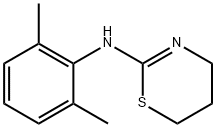Xylazine

- CAS No.
- 7361-61-7
- Chemical Name:
- Xylazine
- Synonyms
- Xylazine (free base);2-(2,6-dimethylanilino)-5,6-dihydro-4h-1,3-thiazine;wh7286;Xylazin;bay1470;XYLAZINE;Mobay Rompun;Xylazine (CRM);Xylazine, >=99%;Xylazine powder
- CBNumber:
- CB8130978
- Molecular Formula:
- C12H16N2S
- Molecular Weight:
- 220.33
- MOL File:
- 7361-61-7.mol
- MSDS File:
- SDS
- Modify Date:
- 2025/1/27 9:38:02
| Melting point | 140 C |
|---|---|
| Boiling point | 334.2±52.0 °C(Predicted) |
| Density | 1.0905 (rough estimate) |
| refractive index | 1.5700 (estimate) |
| storage temp. | -20°C |
| solubility | Soluble in methanol at 50mg/ml. Also soluble in dilute acid solutions. |
| form | Powder |
| pka | 7.67±0.20(Predicted) |
| InChI | InChI=1S/C12H16N2S/c1-9-5-3-6-10(2)11(9)14-12-13-7-4-8-15-12/h3,5-6H,4,7-8H2,1-2H3,(H,13,14) |
| InChIKey | BPICBUSOMSTKRF-UHFFFAOYSA-N |
| SMILES | S1CCCN=C1NC1=C(C)C=CC=C1C |
| CAS DataBase Reference | 7361-61-7(CAS DataBase Reference) |
SAFETY
Risk and Safety Statements
| Symbol(GHS) |  GHS06 |
|||||||||
|---|---|---|---|---|---|---|---|---|---|---|
| Signal word | Danger | |||||||||
| Hazard statements | H301 | |||||||||
| Precautionary statements | P301+P330+P331+P310 | |||||||||
| Hazard Codes | T,Xi | |||||||||
| Risk Statements | 25-36/37/38 | |||||||||
| Safety Statements | 45-37/39-26 | |||||||||
| RIDADR | UN 2811 6.1/PG 3 | |||||||||
| WGK Germany | 3 | |||||||||
| RTECS | XJ0776300 | |||||||||
| HazardClass | 6.1 | |||||||||
| HS Code | 2934990002 | |||||||||
| Toxicity | LD50 in mice (mg/kg): 43 i.v.; 121 s.c.; 240 orally; LD50 in rats (mg/kg): 130 orally (Sagner) | |||||||||
| NFPA 704 |
|
Xylazine price More Price(2)
Xylazine Chemical Properties,Uses,Production
Description
Xylazine is an agonist of α2-adrenergic receptors (Ki = 194 nM). It is an analog of clonidine, an α2-adrenergic receptor agonist used to reduce blood pressure. Xylazine is used for sedation, anesthesia, and analgesia in non-human mammals. This product is also available as an analytical reference standard .
Uses
Xylazine is an α2 class of adrenergic receptor agonist. Xylazine is a clonidine analoque that acts on presynaptic and postsynaptic receptors as an a 2-adrenergic agonist.
Origin
Xylazine was discovered as an antihypertensive agent in 1962 by Farbenfabriken Bayer in Leverkusen, Germany. Accounts of the actions and uses of xylazine in animals were reported as early as the late 1960s and early 1970s. Results from early human clinical studies confirmed that xylazine has several central nervous system depressant effects.
General Description
Xylazine is soluble in methanol (50 mg/ml), yielding a clear, colorless solution. It is also soluble in dilute HCl acid and in chloroform. Xylazine is practically insoluble in water and in alkali solutions.
Mechanism of action
Xylazine is marketed as its hydrochloride salt as Rompun (100 mg/mL) and Anased (20 mg/mL) injectable solutions for intravenous administration to horses and dogs, respectively. The actions of xylazine may be reversed by the administration of yohimbine, an indolalkylamine alkaloid, that blocks those α2- adrenoreceptors that are stimulated by xylazine.
Side effects
High doses of Xylazine can cause dizziness, vomiting, high blood sugar, blurry vision and even overdose deaths. If you inject xylazine into your body, you also may develop skin ulcers and severe wounds that can spread and worsen quickly.
Xylazine can lead to depression of the central nervous system along with other adverse effects. As for animals, they may show profound salivation following an injection with xylazine. Other adverse effects for dogs and cats include: muscle tremors, bradycardia with AV-block, hypotension, reduced respiratory rate, movement in response to strong auditory stimuli, and increased urination in cats.
Safety Profile
Poison by ingestion, subcutaneous, and intravenous routes. Human systemic effects: change in motor activity, fall in blood pressure, miosis, pleural thickening, pulse rate decrease, somnolence. When heated to decomposition it emits very toxic fumes of NOx and SOx.
Xylazine Preparation Products And Raw materials
Related articles
- Synthesis and Biochemical Effects of Xylazine
- Xylazine has sedative, analgesic and central muscle relaxant effects.
- Aug 31,2022
7361-61-7(Xylazine)Related Search:
1of4
chevron_right




